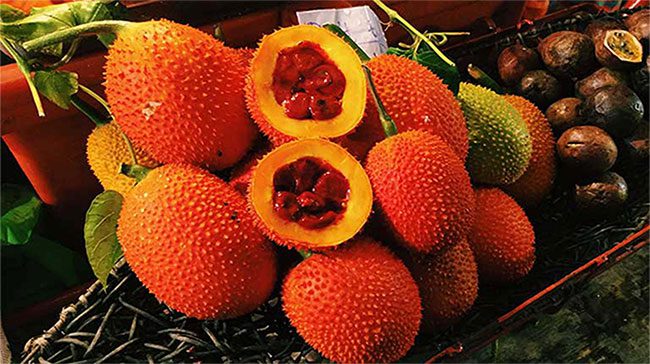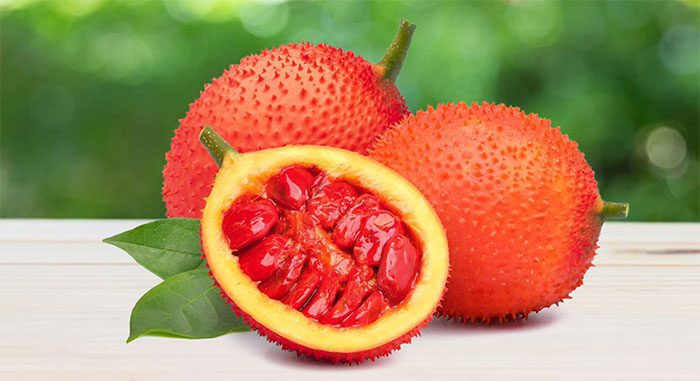This fruit is revered as a superfood because it helps combat cancer and prevent cardiovascular diseases.
When it comes to Gac fruit, there is likely no Vietnamese person who is unfamiliar with it. Gac is a bright red fruit with a surface covered in short spines. It is typically large, about 13 cm long, with a diameter of 10 cm, and has a spherical or oval shape, with a sharp and hard stem protruding from it.
When young, Gac fruit is green. As it ripens, it changes from orange-red to deep red. The fruit has spines on the outside, with flesh and seeds inside. In Vietnamese markets, Gac is sold at prices ranging from 60 to 80 thousand VND per kilogram.
For the Vietnamese people, Gac is a familiar fruit. Especially during holidays and festivals, Gac is widely used to make sticky rice and offerings for ceremonies. In international cuisine, Gac is celebrated as a food from heaven or a superfood (a food rich in vitamins, minerals, and phytochemicals that positively impact health beyond basic nutrition and help reduce disease risk).

Gac is a bright red fruit with a surface covered in short spines.
Let’s take a closer look at the health benefits that this fruit offers.
Cancer Prevention
The flesh of Gac fruit is very rich in lycopene, beta-carotene, and antioxidants. It is important to note that a diet rich in antioxidants reduces the risk of cancer, dementia, heart disease, and depression.
Gac fruit also contains a significant amount of lycopene. Lycopene is a natural compound found in fruits and vegetables that provides remarkable health benefits. Specifically, it helps reduce the risk of stroke, sunburn, and notably, has anticancer effects.
According to several studies published in the United States, compounds such as beta-carotene and lycopene found in Gac oil can neutralize 75% of carcinogens in general, particularly breast cancer in women. The International Journal also states that if women have a significant level of lycopene in their bodies, the risk of cancers such as nasopharyngeal, colorectal, stomach, and esophageal cancer is reduced by five times.
Lycopene is found in naturally red foods like watermelon and tomatoes. In the United States, Americans primarily obtain lycopene from tomatoes or tomato products. Meanwhile, Gac fruit may have a lycopene content up to 70 times higher than that of tomatoes.
On the other hand, lycopene in tomatoes must be cooked with oil to become biologically active in the body, while Gac naturally contains unsaturated fatty acids, allowing lycopene to be dissolved easily. These findings by scientists have elevated Gac to the top position among fruits beneficial to human health.
Brain Boosting, Eye Health, and Skin Benefits
Gac fruit is also very rich in beta-carotene, another plant compound. Beta-carotene supports eye health, memory, and brain strength. Together with the vitamins in Gac, it helps improve human vision and prevent cataracts and other vision problems. Additionally, beta-carotene and other antioxidants act as a form of sunscreen for the body, helping to protect the skin from the harmful effects of sunlight.
Beta-carotene is also abundant in carrots, pumpkins, and squash. These foods do not need to be cooked to absorb the benefits of beta-carotene.

Gac fruit is rich in antioxidants, thus helping to prevent cardiovascular diseases.
Cardiovascular Disease Prevention
As mentioned earlier, Gac fruit is very rich in antioxidants, which help prevent cardiovascular diseases. Cardiovascular disease is currently one of the most dangerous common diseases, affecting the health and lives of many people.
At the Haifa Health Center, experts have discovered that lycopene is a very active antioxidant capable of preventing the oxidation of LDL, harmful cholesterol in the blood, thus preventing atherosclerosis and the risks of stroke.
A study conducted on men, including those with a history of cardiovascular disease and healthy individuals, concluded that those with high lycopene levels would reduce their risk of cardiovascular diseases by 50%.
Blood Sugar Regulation
In May 2007, professors at the University of Tokyo (Japan) successfully researched the use of Gac oil to treat complications of diabetes.
The lycopene content—a type of antioxidative carotenoid—in Gac fruit is found to be ten times higher than in fruits and vegetables considered rich in lycopene. This compound in Gac has been proven to reduce the likelihood of complications caused by diabetes. This further affirms the tremendous nutritional and health value that Gac fruit brings, while also opening new hopes for patients struggling with diabetes every day.
Anti-inflammatory, Stress Reduction
In addition to lycopene and beta-carotene, Gac fruit is also rich in omega-3 fatty acids and alpha-tocopherol. These nutrients all have anti-inflammatory effects, while also helping to reduce stress arising from daily life.



















































